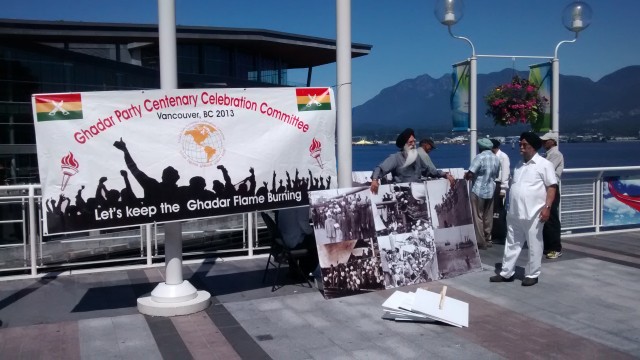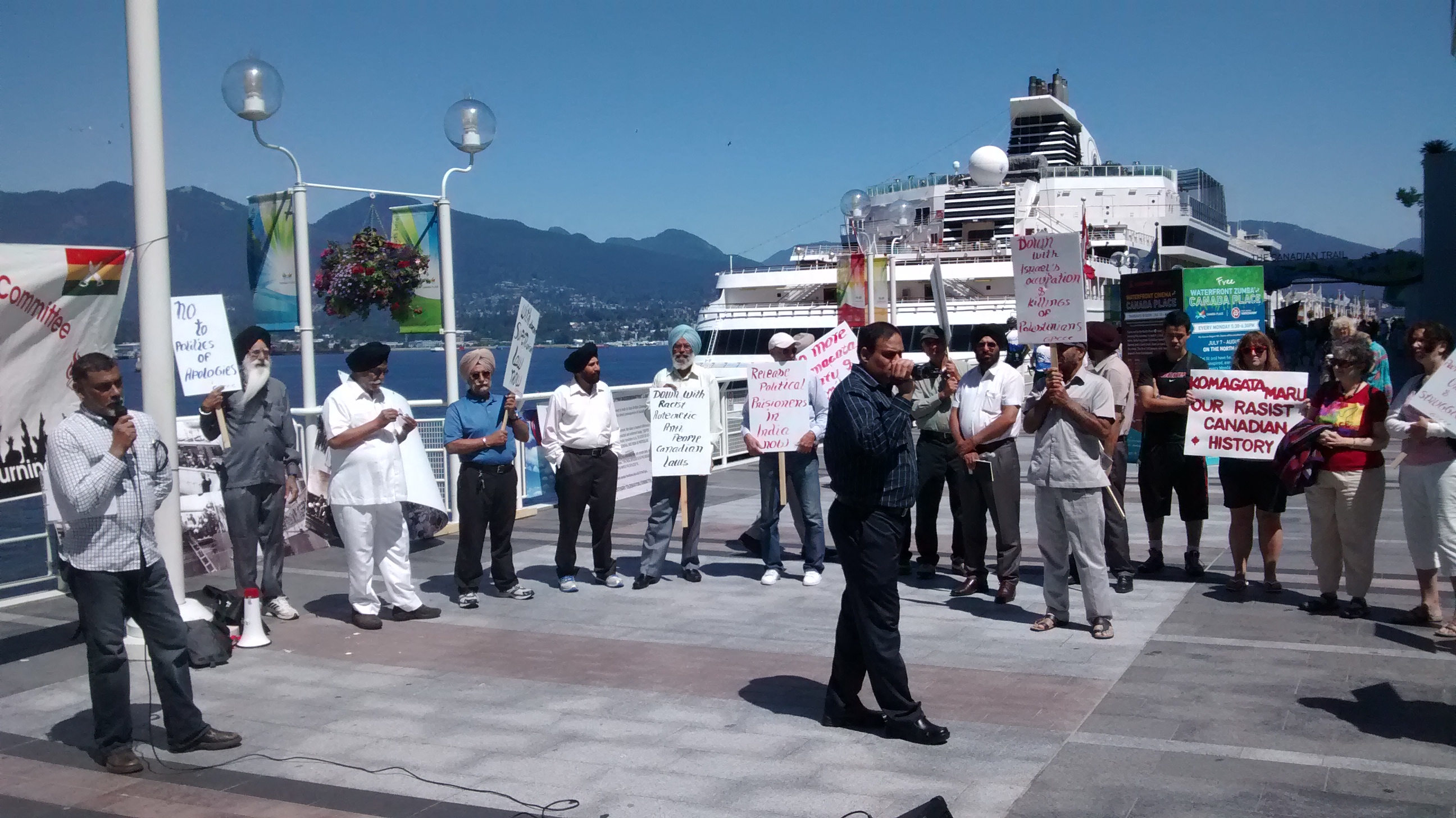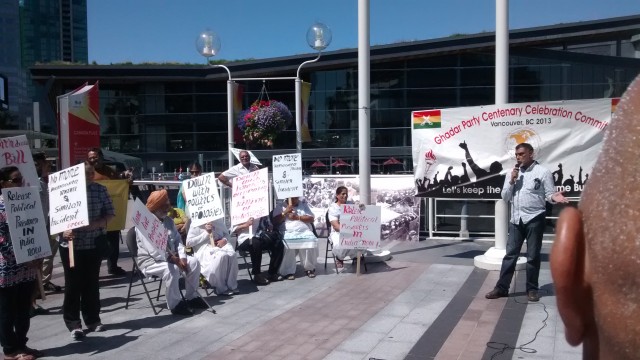Connecting the Old Canada with the New Canada: a legacy of Racism
By Tascha Shahriari-Parsa

Participants setting up for the Rally on July 27, 2014 to commemorate the anniversary of the Komagatu Maru.
On May 23 rd , 1914, the Komagata Maru steamship arrived in Vancouver with 376 passengers who were fleeing India. There were already over 2000 Indians living in Canada, primarily Punjabis, who faced blatant discrimination. Due to racist government policies to keep out the so called ‘brown invasion’, the passengers of the ship were not let off, and the Komagata Maru was forced to return to India by the Canadian government. 20 of the passengers were killed upon arrival by British colonialists’ bullets.
That was the ‘ old Canada’ . Now, one hundred years later in what we might consider the ‘ new Canada’ , people of different nations, led by the Indian community, stood together on July 27 th , 2014 in Vancouver to commemorate the anniversary of the incident. It wasn’t, however, a passive commemoration. It was not the kind of commemoration that merely acknowledges the barbarity of the past and takes an idle stance on the present. It was not only a day to reflect on the racist government policies of the past, but also a day to connect them with the present. It was a day for marginalized and oppressed communities to voice resistance against the racism that is integral to colonialism and imperialism and the power of oppressive classes today, both in Canada and around the world.
Just over a hundred years ago, the Continuous Passage Act of 1908 was one of the discriminatory laws passed by the Canadian government, a law that required all immigrants to travel to Canada in an uninterrupted journey . The law made it extremely difficult for Asian immigrants to enter Canada, since most trips from Asia involved stops, and actually made it impossible for Indians to enter Canada as immigrants since there were no steamship lines that provided direct service between India and Canada.[1] To combat this blatantly racist law, Baba Gurditt Singh Sandhu led the journey of the Komagata Maru ship to challenge the act.
“ Going a little further back in time ,” spoke Lakhbir, from the Ghadar Party Centenary Celebrations Committee and the East Indian Defence Committee, “ we can see that the economic hard-ships and social desperation that the Punjabi farmers faced due to increased taxation by British Colonialists on farmers forced them to flee the hell of colonial rule to look for better work opportunities. As the British subjects began to arrive in regions like Canada, part of the British Common Wealth, the Immigration laws became more and more discriminatory against the ‘undesirable ones’. The excuse given by the then Government was to avoid conflict between locals and immigrants, because locals feared job loss to immigrants.”

Lakhbir, from the Ghadar Party Centenary Celebrations Committee and the East Indian Defence Committee
Thinking back to this incident, it is important that we do not see it in isolation, but rather understand that racism is and has always been inherent in the settler colonialism on which this country was founded; the appropriation of land and rapid accumulation of capital that once funded the British Empire and now serves the Canadian imperialist ruling class would not be possible without this racism.
If we think back in time to 1492, when Christopher Columbus arrived in the Americas, the Europeans immediately began their plans to subjugate the Indigenous people. “They ought to make good and skilled servants…” Columbus writes early on, “With 50 men, you could subject everyone and make them do what you wished,” he said. This was a war of conquest, pursued with racist justifications for the purpose of economic domination. Merely 4 years after Columbus’s arrival in the island of Hispaniola, shared by the modern day Dominican Republic and Haiti, half of the 8 million Indigenous peoples on the island were dead. In the coming decades, this genocide spread through Mexico, Central America, and Peru, killing tens of millions of indigenous people, arguably comprising the most devastating holocaust of history.
The Europeans did not simply arrive in North America for the purposes of settlement – the indigenous peoples were enslaved, forced to work on their own land to grow crops for Europe or extract silver and gold through perilous mines – very similarly to the British occupation of India and the imperialist ventures that continue to exploit the Indian people today. Racism was so vital to this exploitation that it became in and of itself part of the rule of law: racism that has managed to exist independently of economic incentives and racism that has itself governed the nature of society.
Evidently, the refusal of the Komagata Maru very much fits into this legacy of racism. As Lakhbir continued, “On the other hand there were 400,000 immigrants admitted to Canada from Europe in 1913 alone: a figure that remains unsurpassed to this day. One wonders then, if this was really not an act designed as a policy to keep Canada ‘White’? One of the most important reasons was certainly, as we strongly believe, the initiations of National Liberation aspirations and fervour amongst Indian people. The heroic legacy of Indian People in resisting occupation and embarking on the liberation struggle, soon after the occupation was complete, is known to the world. The great Ghadar movement of 1857 is also known as last battle of resistance against occupation and first battle for National liberation. And the 1857 Ghadar rebellion has since inspired, generation after generation of Indian people to wage pitched battles against unjust rule .”
That was the old Canada . What about the new Canada?
As if to make us certain that racism persists today in the policies of our governments, the Federal government of Canada recently passed Bill-C24: The Strengthening Canadian Citizenship Act . This is a Bill that is so illegitimate that it violates International Law on Citizenship. Now, the citizenship of a person born in Canada can be revoked if they are thought to be able to claim citizenship in another state through one of their parents – even if that person has absolutely no connection to their parent’s country. What might merit such a revocation? The criteria is membership in “an armed force of a country or as a member of an organized armed group and that country or group was engaged in an armed conflict with Canada” or engagement “ in certain actions contrary to the national interest of Canada ”.
The wording of this bill is so vague, who knows what could constitute “actions contrary to the national interest of Canada.” What is the national interest of Canada, and who decides it? ; Certainly not the indigenous people whose interests are completely ignored by the colonial government. Rather, the decision is made by the Minister of Immigration and Citizenship, on paper, without a hearing of any sort ; The minister merely provides a notice of intent to revoke Citizenship, allows for a letter in response, and then makes a decision. Not only that, but the minister must have only “reasonable grounds to believe” that a person possesses or could possess citizenship to another country in order to deport them – someone who is incorrectly perceived to hold citizenship elsewhere could become stateless , breaching article 15 of the Universal Declaration of Human Rights.
Bill C24 has been part of a long line of actions, taken by this government, to persecute the very same people who are fleeing persecution and seeking asylum in Canada. In 2012, the Protecting Canada’s Immigration System Act made it so that any group of refugees coming to Canada without papers, by boat or air, could be detained for up to a year without any form of judicial review . The Immigration Minister also brought forth a racist list of 27 nations that he deemed to be ‘safe countries’, making it so that Roma people fleeing persecution from Hungary would have no chance of being accepted as refugees in Canada. In the same year, the conservative government also cut health care for refugees, depriving them from life-saving medication, until the Federal Court struck down the government’s changes in July of 2014.
These racist policies of the Canadian government show that even the thin veil of ‘democracy’ that exists is being taken away – or perhaps its inexistence is becoming clear. People sometimes believe that we have democracy because of the court system, as we have the right to a fair trial and that the rule of law governs over them with justice; but as the capitalist crisis has hit post-recession, the state can’t even afford to put on a facade of democracy anymore. We see this with the stripping away of social programs, the implementation of brutal austerity measures, and bills like C-24.
Thus, while we commemorate the anniversary of the Komagata Maru, it’s important that we do not make the mistake of believing that racist government policies are a mere thing of the past. They have been ingrained in our system since the inception of our settler colonial state and they continue to persist today. The Canadian government has left us with nothing other than what the East Indian Defence Committee considers the “eye-wash politicsof Apologies” : what good are apologies for racist policies of the past when equally racist policies are being enacted in the present?
“Welcome to the new Canada,” said Aiyanas Ormand, a writer for BASICS, on behalf of the International League of People’s Struggle and Red Sparks Union, “Sadly, it is very much like the old Canada that so ruthlessly turned away the Komagata-Maru.”
“We urgently need to build an alliance of oppressed people capable of not only waging powerful defensive battles, but also of linking with the revolutionary movements developing in the global South and of fighting for social transformation here in the belly of the beast,” Aiyanas continued. “We need an alliance of Indigenous peoples, people of oppressed nationalities, and the super-exploited multi-racial working class organized on a firm basis of anti-racism, anti-capitalism, women’s liberation and internationalism.
“The positive Komagata-Maru legacy has been the role of the South Asian community, in Vancouver, leading many very important struggles for social justice, and in linking us here to the great movements of the subcontinent for national and social liberation. Today, we should all commit to carrying on this legacy until this rotten racist patriarchal imperialist system is finally overthrown.”
Therefore, let us stand for the legacy of the ship, and actively fight against racism and all other forms of oppression in the spirit of its passengers.
The Komagata Maru rally was organized by the Ghadar Party Centenary Committee and supported by International League of People’s Struggles, No One is Illegal, Red Sparks Union, and the Revolutionary Student Movement. The following resolutions were also unanimously adapted:
- This rally resolves to dedicate itself to the memory of the Passengers aboard Komagata Maru, who endured ugly unwelcoming gestures upon their arrival in Canada, inhuman conditions while they awaited their fate in the waters of the Burrard Inlet, and death for 20 of them (a miserable life for the rest) on return to India.
- This rally resolves to call upon people to unite and fight against all the anti-people laws, such as Bill C-24, being enacted and enforced to devastate people’s lives. It further calls upon people to stand united and vigilant against the recurrence of Komagata Maru-like incidents.
- This rally believes that, the politics of apologies is nothing more than a corrosive eye wash for people. This rally resolves to denounce the “POLITICS OF APOLOGIES”.
- This rally resolves to denounce the “BILL C-24”, the so called ‘citizen-ship strengthening act’. The rally further resolves to challenge the BILL C-24 and call for its immediate withdrawal.
- This rally resolves to denounce Israel’s occupation of Palestinian Nation, present attack on civilian population in Gaza, killings of innocent women and children. This rally further denounces the WAR CRIMES being committed by Apartheid Israel state. This rally resolves to be in solidarity with Palestinian people’s struggle for freedom.
- This rally resolves to support the Native people’s struggle for their rights.
- This rally resolves to denounce the Fascist Indian state, which crackdown on people’s democratic rights. It further resolves to call for an immediate end to Operation Green Hunt and other such operations. This rally also resolves to Demand for the release of all political prisoners in India.
[1] http://www.whitepinepictures.com/seeds/i/10/sidebar.html
Comments

